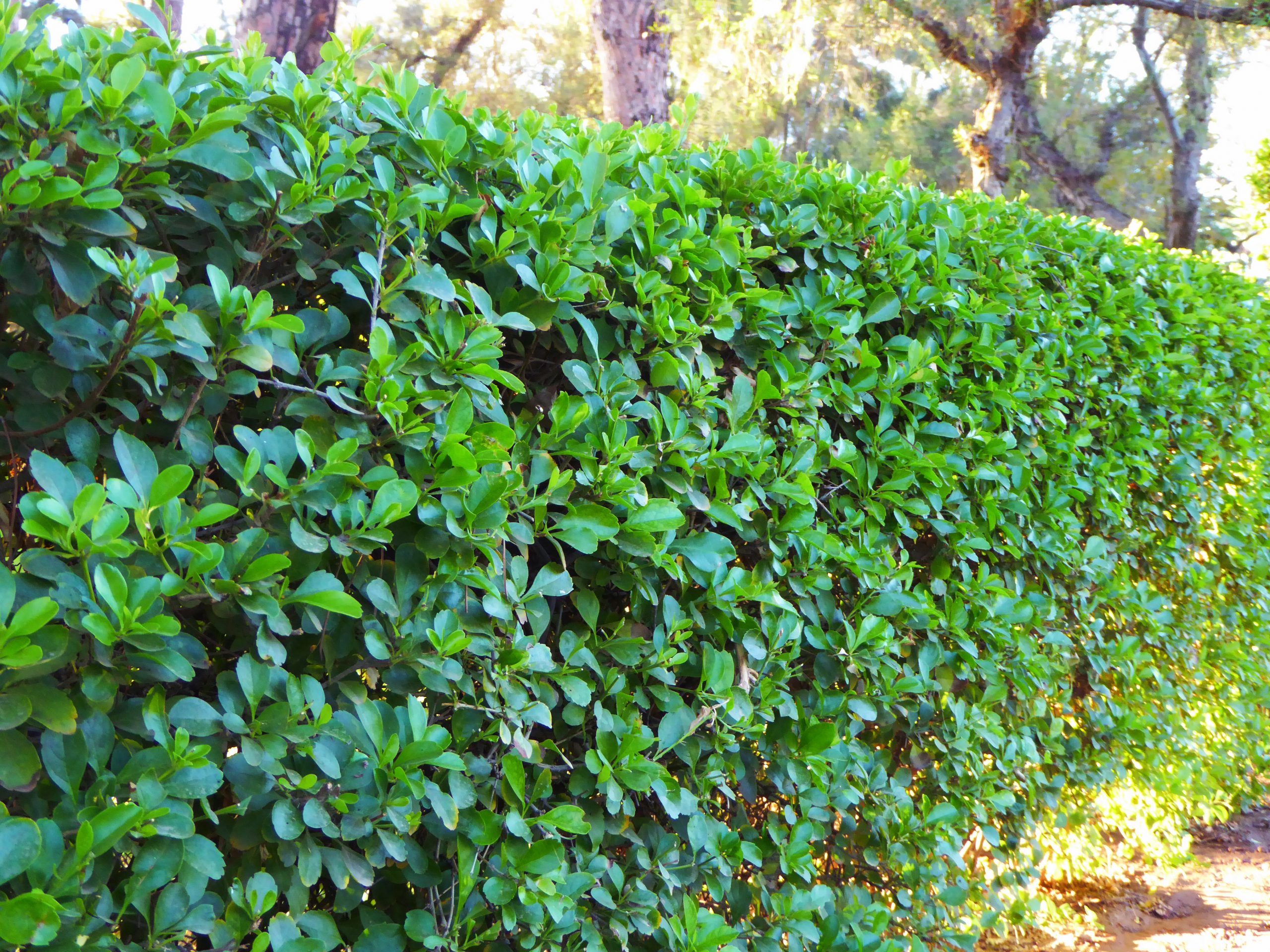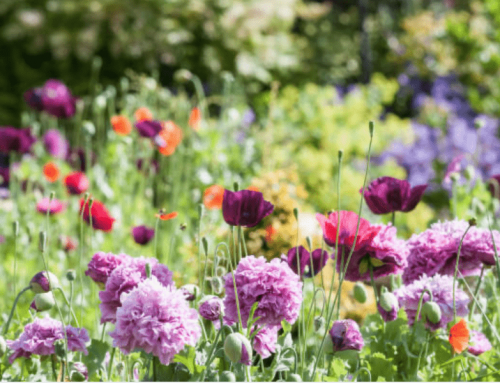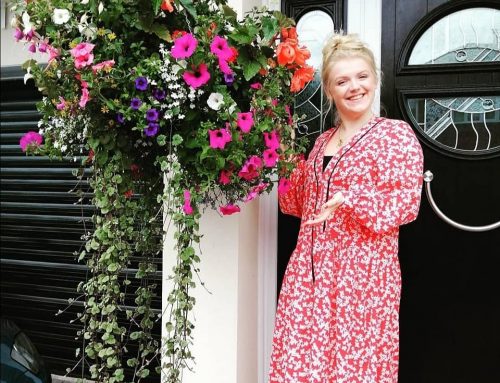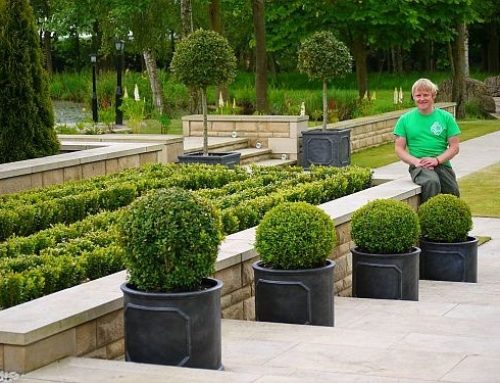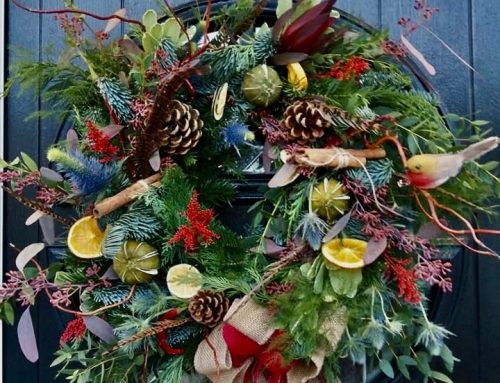Garden hedging can be used to form boundaries in your garden, to add structure and shape to gardens as well as offering security and ideal habitats for wildlife and nesting birds. The majority of Green Onion Landscaping’s clients’ prefer evergreen garden hedging in their garden spaces. Evergreen hedges supply colour in the garden all year round. Evergreen hedging can be much more costly than deciduous hedging, however, it offers many benefits in giving privacy, disguising unattractive features in yours or your neighbours garden, providing safe nesting places for the birds and a great backdrop to any other colourful plant you may put in front of them.
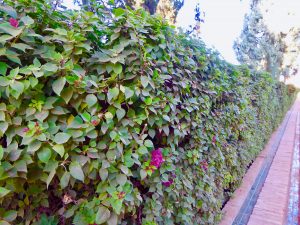
Green Onion Landscaping offer:
- Bare root hedge planting which is low in cost
- Pot planted garden hedges which can be a little more expensive however the specimens tend to be larger than bare-root plants
- Semi mature garden hedging plants for instant screening and hedging, this, of course, this will be more costly but gives an instant, beautiful hedge.
There are many different types of garden hedges i.e decorative hedges, statement hedges, security hedges to name but a few. There is also a multitude of various hedging plants to chose from to create a garden hedge. Let’s take a look at our most popular hedging ideas and the hedging plants you can choose to create these.
Intruder hedging/security garden hedges:
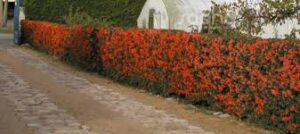
Pyracantha (Firethorn) – This is the top requested hedging plants for garden/boundary security. It has extremely dangerous thorns, it’s evergreen, has very pretty, creamy/ white fragrant flowers in summer and in winter it produces profuse berries in red, orange or yellow. This is a fantastic hedge to use for a secure boundary garden hedge. The growth rate of Pyracantha hedging is 30 -40 cm per year. Green Onion Landscaping can supply these hedging plants to you at 1.5 -1.75m in height to create an instant and effective security hedge in your garden.
Hawthorn – (Quickthorn) – Hawthorn hedges are typically used by farmers, they can provide miles and miles of beautiful hedging. Hawthorn’s pretty spring green leaf is very attractive. It has a wonderful blossom and produces red Hawthorn haws so profuse that the entire bush looks a stunning bright red colour in winter. It is deciduous although it has a very strong network of thorns and strong branches. Wildlife and nesting birds love Hawthorn hedges.
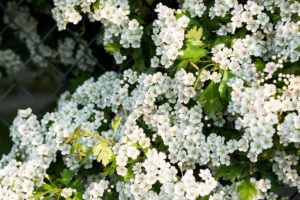
Buxus Box hedging and shaped Buxus Topiary
Why not add a bit of interest to your garden, some structure and shape. You could use Buxus hedging to create a beautiful, ornate garden hedge. This is one of our landscaping projects in Whinney Hill, Stockton, Teesside.
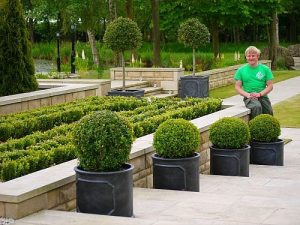
Coastal garden hedging – Providing hedging for a seaside garden can be a bit of a challenge due to the winds and sea salt spray. Not many plants like these conditions. Here are a few great coastal hedging plants Green Onion Landscaping has chosen as ideas for you.
Escallonia – A stunning garden hedging idea- Another stunning example of a plant which can create an evergreen hedge. Escallonia’s dark shiny leaves and the long flowering period of red, pink or white flowers make this one super attractive plant to use for your garden hedging. We would not recommend using this for a hedge in very cold coastal areas as it can lose leaves if it gets too cold.
Griselinia hedging – A gorgeous evergreen hedging plant with bright apple green leaves, Griselina provides a year-round beautiful, fresh, healthy-looking hedge.
Cherry Laurel or Common Laurel (Prunus Laurocerasus) – Laurel hedging plants have glossy bright green leaves, they’re very good at keeping their leaves in the winter, they’re fast-growing and very easily grown almost anywhere.
Privet ( Ligustrum Ovalifolium) – Privets make excellent hedges, even in highly polluted areas. They’re fast-growing but will lose some leaves in very cold weather.
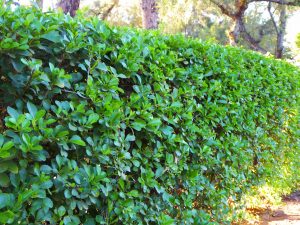
Yew (Taxus Baccata) – Yew trees are considered the King of all hedging plants. Their luxurious, lush, dense, very dark green foliage gives these trees a very regal, expensive look. Yews are slow-growing, however, they are relatively easy to maintain.
Photinia Red Robin (Photinia x fraseri ‘Red Robin’)
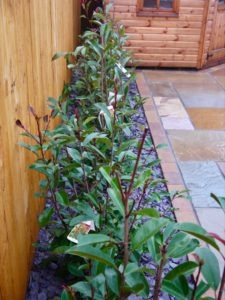
Photinia is a stunning hedging plant. Photinia’s leaves are dark green, new growth comes through bright red and stays red for the Summer and Autumn. This is a wonderful evergreen hedging plant.
When to plant your garden hedging
If you’re thinking of planting a semi-evergreen garden hedge such as Privet, Box or Yew then this should ideally be carried out in early autumn through to late winter. Deciduous hedges, for example, Beech, Hornbeam or Hawthorn should be plated in mid-autumn to late winter. Green Onion Landscaping will help you to choose which type of hedging plant would best suit your garden’s needs. There are of course many types of shrubs/trees that can be used for hedging in your garden. Visit Green Onion Landscaping’s soft landscaping page for more planting ideas. Green Onion Landscaping offer free quotations. We will help you chose the right type of boundary or decorative hedging for your garden landscape.
Achieving balance with mixed hedging plants
There are some pretty simple guidelines you can follow to understand balance of your hedging plants. Imagine you have bought a dining table that will seat 8 people. You are now searching for 8 chairs. Your options could be:
8 chairs all the same (obviously – but hardly ‘mixed’),2 sets of 4, 2 sets of 3 and 1 set of 2, 1 set of 6 and 1 set of 2, 8 all different – This is sometimes known as the ‘Harlequin Set.’ There’s nothing wrong with a Harlequin Hedge’ but not in a small area.
But what will not work for example is: 1 set of 5, 1 set of 2 and 1 on its own, 1 set of 3, 2 sets of 2 and 1 on its own.
Obviously, hedging plants don’t come in a fixed format like chairs, however, this general rule of numerical symmetry does still apply.
We also recommend that if you’re going to have a mixed hedge planted, each plant species should be planted at least two-a-breast to avoid it looking like a strange, blobby mass!
Compatibility of mixing hedging plants
For a mixed hedge to thrive, all the plants chosen must enjoy your garden’s current conditions which are created by the soil type, situation and saturation
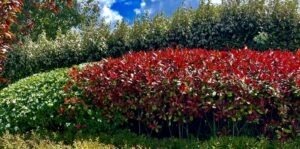
Growth rates
Then the growth rate of each species of hedging plant must also be considered. Unless you are extremely patient, you probably don’t want to mix hedging plants in a single hedge that won’t reach your optimum height within more than two, possibly three, seasons of each other. Different growing rates can be compensated for by planting larger specimens of the slower growing plants. If you don’t do this you’ll need to accept that your new hedge will be an eyesore for a good while whilst the other hedging plants grow to reach the height of the larger ones
Soil
Copper Beech and Cherry Laurel prefer an alkaline soil, though the latter can cope with a mildly acidic soil
Beech, Box, Escallonia Macrantha Rubra, Griselinia Littoralis, Hornbeam, Leylandii, Lonicera, Photinia, Privet and Yew are happy in either acid or alkaline
Situation
Leylandii, Photinia and Copper Beech require full sun
Beech, Box, Escallonia Macrantha Rubra, Griselinia Littoralis, Hornbeam, Cherry Laurel, Lonicera, Privet and Yew are happy in any situation from full sun to partial shade.
Escallonia Macrantha Rubra and Griselinia Littoralis both require a degree of shelter
Saturation
Most hedging plants require good drainage, so if your soil is, for example, truly waterlogged (say through heavy clay), your choice of hedging plants is restricted to Hornbeam only
Cherry Laurel, Privet, Copper Beech and Yew all prefer dry soils
Beech, Box, Escallonia Macrantha Rubra Griselinia, Littoralis, Leylandii, Lonicera and Photinia are happy on any soil as long as it is well-drained


